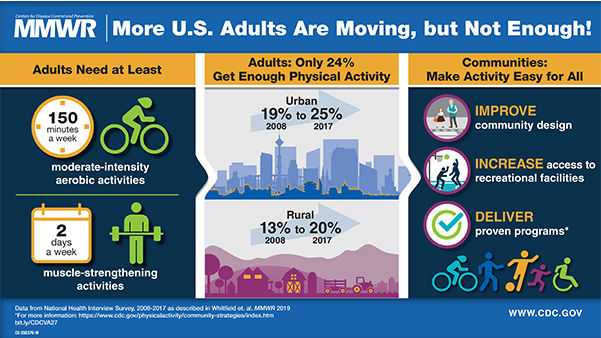Motivation
New Report Shows Promising Trend in People's Exercise Habits
More people across the U.S. are working out than in 2008, but 76% are inactive.
Posted June 16, 2019
If people across the United States could collectively give each other a fist bump, high five, or pat one another on the back for achieving recommended weekly exercise guidelines, now would be the time. This week, the CDC released a new report, "Trends in Meeting Physical Activity Guidelines Among Urban and Rural Dwelling Adults — United States, 2008–2017," which found that over this 10 year period, the percentage of U.S. adults who are getting enough physical activity increased from 19 to 25 percent in urban areas and from 13 to 20 percent in rural areas. This is great news!

The bad news is that across the nation, only 24 percent of the total adult population gets enough exercise—which amounts to roughly 150 weekly minutes (22 mins. daily) of moderate-intensity aerobic activity and two muscle-strengthening workouts per week.
These findings were published June 14 in the U.S. Centers for Disease Control and Prevention Morbidity and Mortality Weekly Report. As you can see in the slightly finger-wagging headline of the MMWR diagram above, "More U.S. Adults Are Moving, but Not Enough!" Clearly, all of us public health advocates still have some work to do. "Despite recent increases in meeting physical activity guidelines, insufficient participation in physical activity remains a public health concern," the CDC authors concluded.
The new CDC report also provides specific details about the current exercise guidelines that were introduced in 2018:
[Our] physical activity guidelines recommend that adults perform at least 150–300 minutes of moderate-intensity, or 75–150 minutes of vigorous-intensity aerobic physical activity per week, or an equivalent combination of moderate- and vigorous-intensity aerobic physical activity (i.e., the aerobic guideline). In addition, adults should do muscle-strengthening activities of at least moderate intensity that involve all major muscle groups on ≥2 days per week (i.e., the muscle-strengthening guideline).
Since 2007, when I published The Athlete's Way: Sweat and the Biology of Bliss, I've kept my antennae up for any science-based evidence that could motivate people to exercise more. Over the past decade, I've written hundreds of blog posts that offer countless reasons to exercise beyond just losing weight or reducing someone's risk of disease. Exercise helps to boost brain power, ward of cognitive decline, combat depression, reduce anxiety, stimulate creativity, etc.
After reading this new CDC report, I decided to put together a "Top 10" list of blog posts that have inspired readers to “exercise more and sit less” as a possible source of motivation for the 76 percent of U.S. adults who still aren’t getting enough exercise. However, after reviewing a dozen exercise-related posts I’ve written in the first half of 2019, I realized the list needed to be expanded to a "Top 25." There are so many reasons to seek exercise!
Hopefully, one of these posts will resonate with you and provide some motivation to exercise for at least 22 minutes per day and lift weights twice a week.
25 Underappreciated Reasons to Make Exercise a Daily Habit
- The Newly-Proven Antidepressant Powers of Exercise
- Alpha Brainwaves, Aerobic Activity, and the Creative Process
- Exercise May Promote Gene Expression of Feel-Good Chemicals
- More Evidence That Physical Activity Keeps Depression at Bay
- Morning Exercise May Improve Decision-Making During the Day
- 30 Minutes of Aerobic Exercise Supercharges Semantic Memory
- Motivation to Run (or Not to Run) Is Linked to Cannabinoids
- Walking Study Corroborates Hippocrates’s Prescriptive Wisdom
- Aerobic Exercise May Be Key to Better Neurocognition
- Exercise-Linked Irisin May Protect Against Neurodegeneration
- Want to Maintain Total Cerebral Brain Volume? Keep Walking
- Vigorous Physical Activity May Be Key to Successful Aging
- Being Out of Shape in Midlife May Increase Risk for Dementia
- Easy-to-Moderate Exercise Before Bedtime Promotes Deep Sleep
- Soon-to-Be Dads Who Exercise May Have Healthier Kids
- Walking in Natural Environments Nourishes Parent-Child Bonds
- The Powerful Psychological Benefits of Dance
- One Surefire Way to Release Endorphins Into Your Brain
- Why Does Running Faster Speed Up Learning in the Cerebellum?
- Exercise Keeps Us Young at Heart in More Ways Than One
- HIIT Workouts May Be the Best Way to Optimize Body Composition
- How Does a Lifetime of Regular Exercise Slow Aging?
- One Hour of Exercise Per Week Protects Against Depression
- New Research Explains Why Some of Us Really Hate to Exercise
- Physical Activity May Be a Drug-Free Elixir for Chronic Pain
References
"Trends in Meeting Physical Activity Guidelines Among Urban and Rural Dwelling Adults — United States, 2008–2017" Morbidity and Mortality Weekly Report (First published: June 14, 2019)


